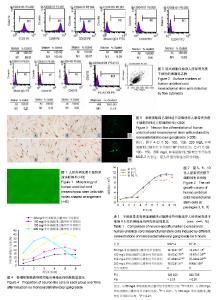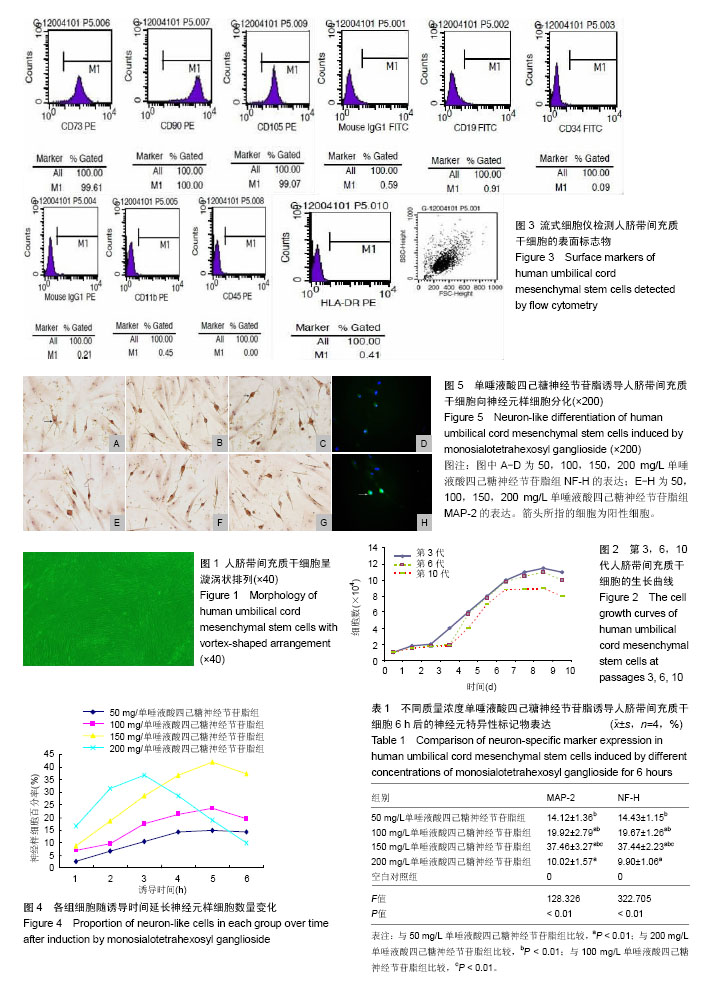Chinese Journal of Tissue Engineering Research ›› 2018, Vol. 22 ›› Issue (13): 2039-2044.doi: 10.3969/j.issn.2095-4344.0490
Previous Articles Next Articles
Monosialotetrahexosyl ganglioside at an optimal concentration: inducing neuron-like differentiation of human umbilical cord mesenchymal stem cells
Zhang Peng1, Zhao Zong-mao2, Li Jian-hua1, Liu Hui1, Liu Yong-jun1, Li Min-jie1, Chen Ming-wei1, Shen Lun1,He Lei1
- 1the First Hospital of Handan, Handan 056000, Hebei Province, China; 2the Second Hospital of Hebei Medical University, Shijiazhuang 050000, Hebei Province, China
-
Revised:2017-12-24Online:2018-05-08Published:2018-05-08 -
Contact:Zhao Zong-mao, M.D., Professor, Doctoral supervisor, the Second Hospital of Hebei Medical University, Shijiazhuang 050000, Hebei Province, China -
About author:Zhang Peng, Master, Attending physician, the First Hospital of Handan, Handan 056000, Hebei Province, China
CLC Number:
Cite this article
Zhang Peng, Zhao Zong-mao, Li Jian-hua, Liu Hui, Liu Yong-jun, Li Min-jie, Chen Ming-wei, Shen Lun,He Lei. Monosialotetrahexosyl ganglioside at an optimal concentration: inducing neuron-like differentiation of human umbilical cord mesenchymal stem cells[J]. Chinese Journal of Tissue Engineering Research, 2018, 22(13): 2039-2044.
share this article

2.1 hUMSCs形态变化以及冻存、复苏、传代对细胞生长的影响 多数原代培养的细胞在12 h内能够贴壁,呈多边形、菱形,逐渐变为长梭形,细胞生长快速,传代稳定,至第10代仍能保持旺盛的增殖能力。将第6代、第10代冻存细胞复苏后以0.8×104/孔的密度接种到24孔板中,大多数细胞在接种24 h内贴壁,在第1,2天处于缓慢增长期,第3天增殖速度明显加快,当细胞融合达到80%时,增殖速度开始减慢,细胞培养至第7天时,细胞呈放射状或漩涡状排列,见图1。复苏各代细胞生长速度的比较无显著差异,细胞生长曲线见图2。 2.2 hUMSCs表面标志物的表达 流式细胞仪检测显示:人脐带间充质干细胞表面标志物CD73、CD90和CD105表达均为阳性,CD19、CD45、CD11b、CD34、HLA-DR(MHC-Ⅱ)表达均为阴性(图3)。 2.3 各组神经样细胞数量及形态变化 各组在诱导后1-3 h均可见神经元样细胞数量增加,50 mg/L单唾液酸四己糖神经节苷脂组最少,200 mg/L单唾液酸四己糖神经节苷脂组最多。 诱导后4 h时,200 mg/L单唾液酸四己糖神经节苷脂组神经元样细胞数量不再增加,其他3组神经元样细胞数量继续增加,这4组细胞形态由纺锤样向双极细胞和多极细胞转变,空白对照组形态未见明显变化。 诱导后5 h时,50,100 mg/L单唾液酸四己糖神经节苷脂组神经元样细胞数量增加不明显,部分细胞开始脱落,150 mg/L单唾液酸四己糖神经节苷脂组神经元样细胞数量最多,但也伴随少量细胞脱落,200 mg/L单唾液酸四己糖神经节苷脂组神经元样细胞数量明显下降,呈片状脱落。 诱导后6 h时,50,100 mg/L单唾液酸四己糖神经节苷脂组神经元样细胞数量不再增加,150 mg/L单唾液酸四己糖神经节苷脂组神经元样细胞数量无明显变化,200 mg/L单唾液酸四己糖神经节苷脂组仅见少量神经元样细胞。 由图4可以看出,200 mg/L单唾液酸四己糖神经节苷脂组前3 h阳性细胞率最高,升高速率也最快,其阳性率达最高值37%,然后神经元样细胞迅速脱落,至6 h降至最低。50,100 mg/L单唾液酸四己糖神经节苷脂组神经元样细胞阳性率缓慢上升,至第5小时达最高值,之后逐渐下降。150 mg/L单唾液酸四己糖神经节苷脂组前5 h上升速率较稳定,至第5小时达最高值42%,之后也均逐渐下降。由此可见,150 mg/L单唾液酸四己糖神经节苷脂组为最佳诱导组。 2.4 诱导细胞鉴定结果 诱导6 h后,大部分神经元样细胞的神经元特异性标记物MAP-2和NF-H免疫细胞化学染色阳性(图5),免疫组织化学染色呈棕黄色,免疫荧光染色呈黄绿色,胶质细胞特异性标记物GFAP免疫细胞化学染色阴性。空白对照组GFAP、MAP-2和NF-H免疫细胞化学染色均为阴性。 由表1可见,任意单唾液酸四己糖神经节苷脂组组间MAP-2及NF-H表达差异均有显著性意义(P < 0.01)。"

| [1] Zhou HX, Liu ZG, Liu XJ, et al. Umbilical cord-derived mesenchymal stem cell transplantation combined with hyperbaric oxygen treatment for repair of traumatic brain injury. Neural Regen Res. 2016;11(1):107-113.[2] Guo ZY, Sun X, Xu XL, et al. Human umbilical cord mesenchymal stem cells promote peripheral nerve repair via paracrine mechanisms. Neural Regen Res. 2015;10(4): 651-658.[3] Van Pham P, Truong NC, Le PT, et al. Isolation and proliferation of umbilical cord tissue derived mesenchymal stem cells for clinical applications. Cell Tissue Bank. 2016; 17(2):289-302.[4] Lian J, Lv S, Liu C, et al. Effects of Serial Passage on the Characteristics and Cardiac and Neural Differentiation of Human Umbilical Cord Wharton's Jelly-Derived Mesenchymal Stem Cells. Stem Cells Int. 2016;2016:9291013.[5] Servais S, Beguin Y, Delens L, et al. Novel approaches for preventing acute graft-versus-host disease after allogeneic hematopoietic stem cell transplantation. Expert Opin Investig Drugs. 2016;25(8):957-972.[6] Ruan ZB, Zhu L, Yin YG, et al. Inhibitor of p53-p21 pathway induces the differentiation of human umbilical cord derived mesenchymal stem cells into cardiomyogenic cells. Cytotechnology. 2016;68(4):1257-1265.[7] Wystrychowski W, Patlolla B, Zhuge Y, et al. Multipotency and cardiomyogenic potential of human adipose-derived stem cells from epicardium, pericardium, and omentum. Stem Cell Res Ther. 2016;7(1):84.[8] Gong X, Wang P, Wu Q, et al. Human umbilical cord blood derived mesenchymal stem cells improve cardiac function in cTnT(R141W) transgenic mouse of dilated cardiomyopathy. Eur J Cell Biol. 2016;95(1):57-67.[9] Deng P, Torrest A, Pollock K, et al. Clinical trial perspective for adult and juvenile Huntington's disease using genetically- engineered mesenchymal stem cells. Neural Regen Res. 2016;11(5):702-705.[10] Wang Y, Ying Y, Cui X. Effects on Proliferation and Differentiation of Human Umbilical Cord-Derived Mesenchymal Stem Cells Engineered to Express Neurotrophic Factors. Stem Cells Int. 2016;2016:1801340.[11] Labrador-Velandia S, Alonso-Alonso ML, Alvarez-Sanchez S, et al. Mesenchymal stem cell therapy in retinal and optic nerve diseases: An update of clinical trials. World J Stem Cells. 2016;8(11):376-383.[12] Kim SW, Jin HL, Kang SM, et al. Therapeutic effects of late outgrowth endothelial progenitor cells or mesenchymal stem cells derived from human umbilical cord blood on infarct repair. Int J Cardiol. 2016;203:498-507.[13] Baksh D, Yao R, Tuan RS. Comparison of proliferative and multilineage differentiation potential of human mesenchymal stem cells derived from umbilical cord and bone marrow. Stem Cells. 2007;25(6):1384-1392.[14] 宁娜,陈乃宏. 神经节苷脂的生物学活性[J].生理科学进展,2009, 40(1):24-30.[15] 顾群.依达拉奉联合神经节苷脂治疗老年急性脑梗死的临床疗效及安全性评价[J].中国临床药理学杂志,2015,31(12): 1079-1081.[16] 罗润嫦,欧列斌,赖永娥,等. 醒脑静注射液治疗急性脑出血疗效观察及对患者血浆纤维蛋白原和 D-二聚体水平的影响[J]. 中国药师,2015,18(9):1542-1544.[17] Moussa L, Pattappa G, Doix B, et al. A biomaterial-assisted mesenchymal stromal cell therapy alleviates colonic radiation-induced damage. Biomaterials. 2017;115:40-52.[18] Cao H, Hui Q, Yan Y, et al. Pretreatments with injured microenvironmental signals altered the characteristics of human umbilical cord mesenchymal stem cells. Biotechnol Lett. 2016;38(1):157-165.[19] Mao X, Liu Y, Chen C, et al. Mesenchymal Stem Cells and Their Role in Dental Medicine. Dent Clin North Am. 2017; 61(1):161-172.[20] Xie Z, Hao H, Tong C, et al. Human umbilical cord-derived mesenchymal stem cells elicit macrophages into an anti-inflammatory phenotype to alleviate insulin resistance in type 2 diabetic rats. Stem Cells. 2016;34(3):627-639.[21] Cui GH, Wang YY, Li CJ, et al. Efficacy of mesenchymal stem cells in treating patients with osteoarthritis of the knee: A meta-analysis. Exp Ther Med. 2016;12(5):3390-3400.[22] Ren S, Hu J, Chen Y, et al. Human umbilical cord derived mesenchymal stem cells promote interleukin-17 production from human peripheral blood mononuclear cells of healthy donors and systemic lupus erythematosus patients. Clin Exp Immunol. 2016;183(3):389-396.[23] Oner A, Gonen ZB, Sinim N, et al. Subretinal adipose tissue-derived mesenchymal stem cell implantation in advanced stage retinitis pigmentosa: a phase I clinical safety study. Stem Cell Res Ther. 2016;7(1):178.[24] Dothel G, Raschi E, Rimondini R, et al. Mesenchymal stromal cell-based therapy: Regulatory and translational aspects in gastroenterology. World J Gastroenterol. 2016;22(41): 9057-9068.[25] 于靓霞,陈芳,孙军,等.脐带间充质干细胞移植治疗大鼠重症肌无力的研究[J]. 中国实验血液学杂志, 2011, 19(3): 744-748.[26] 杨华强,王云甫,李东升,等. 脐带间充质干细胞移植治疗遗传性痉挛性截瘫2例[J]. 中国组织工程研究与临床康复, 2011, 15(1): 167-170.[27] 唐云安,王瑞淑,张成,等.大鼠脊髓匀浆上清液对骨髓间质干细胞的诱导分化作用[J]. 中风与神经疾病杂志, 2003, 20(3): 196-198.[28] 梅晰凡,秦书俭,范广宇,等. 损伤脊髓组织液对大鼠骨髓基质细胞向神经细胞诱导分化的研究[J].中国临床解剖学杂志, 2005, 23(3): 264-267.[29] 宗茂,张庆俊,韩忠朝,等. 骨髓间质干细胞移植对大鼠脊髓损伤神经功能恢复的影响[J] . 中华神经外科杂志, 2003, 19(1): 58-62.[30] Lee JB, Kuroda S, Shichinohe H, et al. A pre-clinical assessment model of rat autogeneic bone marrow stromal cell transplantation into the central nervous system. Brain Res Brain Res Protoc. 2004;14(1):37-44.[31] 王艳,张晋林,黄晓兵,等. 脐带间充质干细胞研究现状与临床治疗[J].重庆医学, 2013,42(18):2161-2163.[32] Schengrund CL, Mummert CM. Exogenous gangliosides. How do they cross the blood-brain barrier and how do they inhibit cell proliferation. Ann N Y Acad Sci. 1998;845:278-284.[33] Levi-Montalcini R. The nerve growth factor 35 years later. Science. 1987;237(4819):1154-1162.[34] 卓豫,廖维宏,吴宝明,等. GM-1对脊髓损伤后神经细胞凋亡的影响[J]. 中国脊柱脊髓杂志, 2003, 13(9): 536-538.[35] 崔文,刘银坤,张夏英,等, 外源性神经节苷脂GM3对Ca2+ -ATP酶及红细胞胞浆Ca2+浓度的影响[J]. 上海医科大学学报,1994, 21(5):385-387.[36] 赵春华,房伯俊,韩钦,等. 亚全能干细胞群生物学特性及移植应用研究[J]. 微循环技术杂志:临床与实验, 2004,8(5) :345.[37] 刘云云, 赵兴绪, 赵洪斌, 等. Ca2+信号介导川芎嗪诱导小鼠骨髓间充质干细胞向神经细胞的定向分化[J].甘肃农业大学学报, 2010,45(2):1-5.[38] Liberini P, Pioro EP, Maysinger D, et al. Long-term protective effects of human recombinant nerve growth factor and monosialoganglioside GM1 treatment on primate nucleus basalis cholinergic neurons after neocortical infarction. Neuroscience. 1993;53(3):625-637. |
| [1] | Lin Qingfan, Xie Yixin, Chen Wanqing, Ye Zhenzhong, Chen Youfang. Human placenta-derived mesenchymal stem cell conditioned medium can upregulate BeWo cell viability and zonula occludens expression under hypoxia [J]. Chinese Journal of Tissue Engineering Research, 2021, 25(在线): 4970-4975. |
| [2] | Pu Rui, Chen Ziyang, Yuan Lingyan. Characteristics and effects of exosomes from different cell sources in cardioprotection [J]. Chinese Journal of Tissue Engineering Research, 2021, 25(在线): 1-. |
| [3] | Zhang Tongtong, Wang Zhonghua, Wen Jie, Song Yuxin, Liu Lin. Application of three-dimensional printing model in surgical resection and reconstruction of cervical tumor [J]. Chinese Journal of Tissue Engineering Research, 2021, 25(9): 1335-1339. |
| [4] | Hou Jingying, Yu Menglei, Guo Tianzhu, Long Huibao, Wu Hao. Hypoxia preconditioning promotes bone marrow mesenchymal stem cells survival and vascularization through the activation of HIF-1α/MALAT1/VEGFA pathway [J]. Chinese Journal of Tissue Engineering Research, 2021, 25(7): 985-990. |
| [5] | Shi Yangyang, Qin Yingfei, Wu Fuling, He Xiao, Zhang Xuejing. Pretreatment of placental mesenchymal stem cells to prevent bronchiolitis in mice [J]. Chinese Journal of Tissue Engineering Research, 2021, 25(7): 991-995. |
| [6] | Liang Xueqi, Guo Lijiao, Chen Hejie, Wu Jie, Sun Yaqi, Xing Zhikun, Zou Hailiang, Chen Xueling, Wu Xiangwei. Alveolar echinococcosis protoscolices inhibits the differentiation of bone marrow mesenchymal stem cells into fibroblasts [J]. Chinese Journal of Tissue Engineering Research, 2021, 25(7): 996-1001. |
| [7] | Fan Quanbao, Luo Huina, Wang Bingyun, Chen Shengfeng, Cui Lianxu, Jiang Wenkang, Zhao Mingming, Wang Jingjing, Luo Dongzhang, Chen Zhisheng, Bai Yinshan, Liu Canying, Zhang Hui. Biological characteristics of canine adipose-derived mesenchymal stem cells cultured in hypoxia [J]. Chinese Journal of Tissue Engineering Research, 2021, 25(7): 1002-1007. |
| [8] | Geng Yao, Yin Zhiliang, Li Xingping, Xiao Dongqin, Hou Weiguang. Role of hsa-miRNA-223-3p in regulating osteogenic differentiation of human bone marrow mesenchymal stem cells [J]. Chinese Journal of Tissue Engineering Research, 2021, 25(7): 1008-1013. |
| [9] | Lun Zhigang, Jin Jing, Wang Tianyan, Li Aimin. Effect of peroxiredoxin 6 on proliferation and differentiation of bone marrow mesenchymal stem cells into neural lineage in vitro [J]. Chinese Journal of Tissue Engineering Research, 2021, 25(7): 1014-1018. |
| [10] | Zhu Xuefen, Huang Cheng, Ding Jian, Dai Yongping, Liu Yuanbing, Le Lixiang, Wang Liangliang, Yang Jiandong. Mechanism of bone marrow mesenchymal stem cells differentiation into functional neurons induced by glial cell line derived neurotrophic factor [J]. Chinese Journal of Tissue Engineering Research, 2021, 25(7): 1019-1025. |
| [11] | Duan Liyun, Cao Xiaocang. Human placenta mesenchymal stem cells-derived extracellular vesicles regulate collagen deposition in intestinal mucosa of mice with colitis [J]. Chinese Journal of Tissue Engineering Research, 2021, 25(7): 1026-1031. |
| [12] | Pei Lili, Sun Guicai, Wang Di. Salvianolic acid B inhibits oxidative damage of bone marrow mesenchymal stem cells and promotes differentiation into cardiomyocytes [J]. Chinese Journal of Tissue Engineering Research, 2021, 25(7): 1032-1036. |
| [13] | Li Cai, Zhao Ting, Tan Ge, Zheng Yulin, Zhang Ruonan, Wu Yan, Tang Junming. Platelet-derived growth factor-BB promotes proliferation, differentiation and migration of skeletal muscle myoblast [J]. Chinese Journal of Tissue Engineering Research, 2021, 25(7): 1050-1055. |
| [14] | Wang Feng, Zhou Liyu, Saijilafu, Qi Shibin, Ma Yanxia, Wei Shanwen. CaMKII-Smad1 promotes axonal regeneration of peripheral nerves [J]. Chinese Journal of Tissue Engineering Research, 2021, 25(7): 1064-1068. |
| [15] | Wang Xianyao, Guan Yalin, Liu Zhongshan. Strategies for improving the therapeutic efficacy of mesenchymal stem cells in the treatment of nonhealing wounds [J]. Chinese Journal of Tissue Engineering Research, 2021, 25(7): 1081-1087. |
| Viewed | ||||||
|
Full text |
|
|||||
|
Abstract |
|
|||||